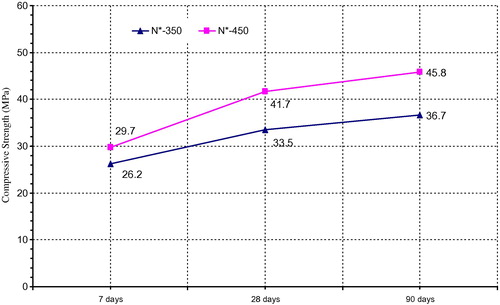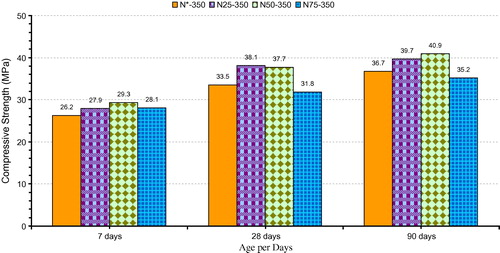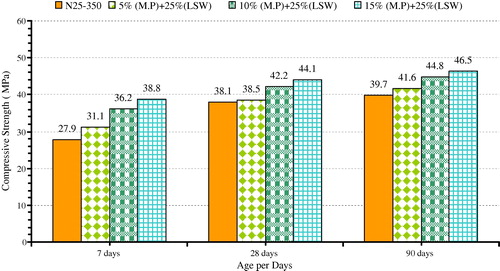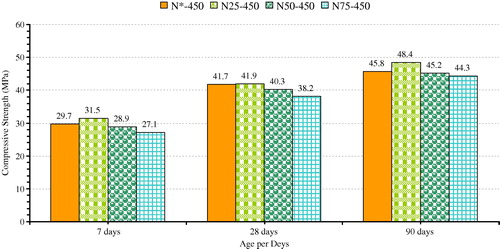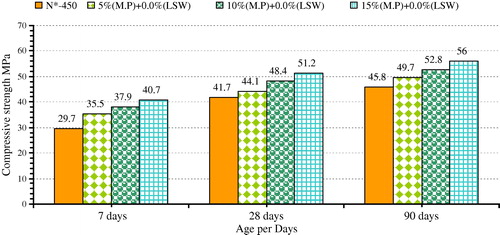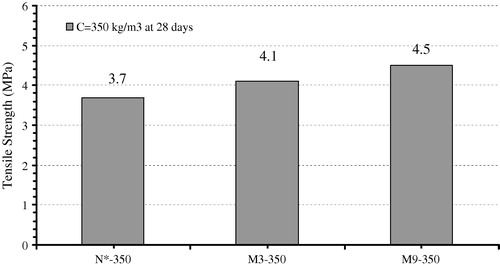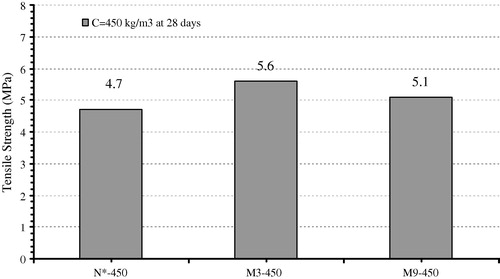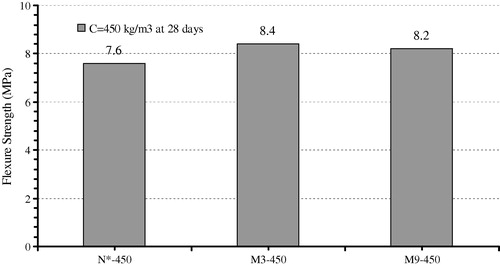 ?Mathematical formulae have been encoded as MathML and are displayed in this HTML version using MathJax in order to improve their display. Uncheck the box to turn MathJax off. This feature requires Javascript. Click on a formula to zoom.
?Mathematical formulae have been encoded as MathML and are displayed in this HTML version using MathJax in order to improve their display. Uncheck the box to turn MathJax off. This feature requires Javascript. Click on a formula to zoom.Abstract
Green concrete are generally composed of recycling materials as hundred or partial percent substitutes for aggregate, cement, and admixture in concrete. Limestone waste is obtained as a by-product during the production of aggregates through the crushing process of rocks in rubble crusher units. Using quarry waste as a substitute of sand in construction materials would resolve the environmental problems caused by the large-scale depletion of the natural sources of river and mining sands. This paper reports the experimental study undertaken to investigate the influence of partial replacement of sand with limestone waste (LSW), with marble powder (M.P) as an additive on the concrete properties. The replacement proportion of sand with limestone waste, 25%, 50%, and 75% were practiced in the concrete mixes except in the concrete mix. Besides, proportions of 5%, 10% and 15% marble powder were practiced in the concrete mixes. The effects of limestone waste as fine aggregate on several fresh and hardened properties of the concretes were investigated. The investigation included testing of compressive strength, indirect tensile strength, flexural strength, modulus of elasticity, and permeability. It was found that limestone waste as fine aggregate enhanced the slump test of the fresh concretes. But the unit weight concretes were not affected. However, the good performance was observed when limestone waste as fine aggregate was used in presence of marble powder.
Introduction
In recent years, green concrete has draws serious attention of researchers and investigators because a concept of thinking environment (Environmentally friendly). The materials used in the production of concrete poses the problem of acute shortage in many areas. That there are many wastes of some industries and quarries can be used as hundred or partial percent substitutes for concrete materials.
Fig. 5 Effect of 50% LSW as a partial replacement of sand weight, with 5%, 10% and 15% MP by weight from cement, phase I (350 kg/m3).
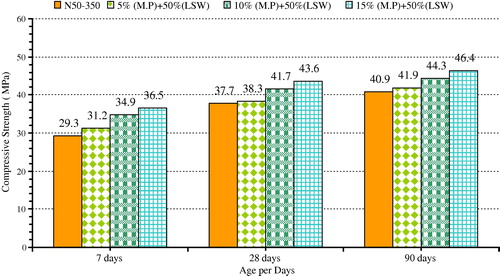
Fig. 6 Effect of 75% LSW as a partial replacement of sand weight, with 5%, 10% and 15% MP by weight from cement, phase I (350 kg/m3).
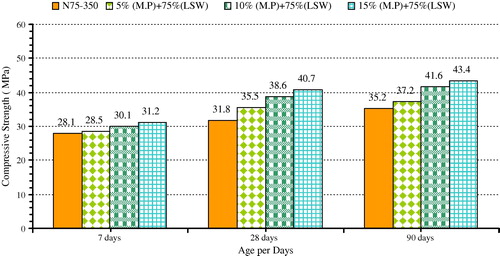
Fig. 10 Effect of 50% LSW as a partial replacement of sand weight, with 5%, 10% and 15% MP by weight from cement, phase II (450 kg/m3).
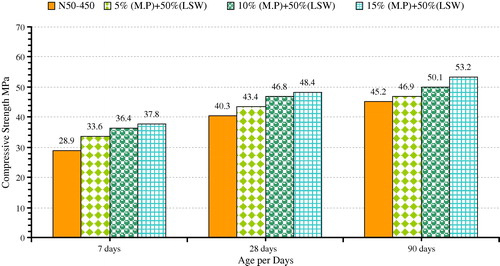
Fig. 11 Effect of 75% LSW as a partial replacement of sand weight, with 5%, 10% and 15% MP by weight from cement, phase II (450 kg/m3).
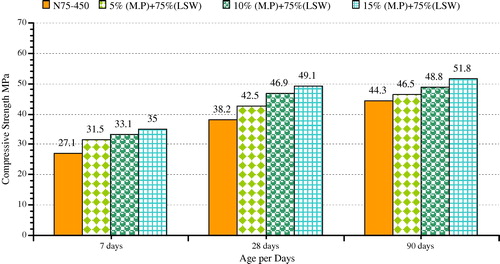
Marble powder obtained as a by-product of marble sawing and shaping [Citation1]. Waste marble powder "WMP" is an inert material which is obtained as an industrial by product during sawing, shaping, and polishing of marble and causes a serious environmental problem [Citation2].
M.S. Hameed et al. [Citation3] studied that the green concrete capable for sustainable development is characterized by application of industrial wastes to reduce consumption of natural resources, energy and pollution of the environment. Green concrete is very cheap to produce, because, waste products are used as a partial substitute for cement, charges for the disposal of waste are avoided, energy consumption in production is lower, and durability is greater. Green concrete gives an excellent result in strength and quality aspect. Waste can be used to produce new products or can be used as admixtures so that natural sources are used more efficiency and the environment is protected from waste deposits. They concluded that the replacement of fine aggregate with 50% marble powder and 50% quarry rock dust green concrete gives an excellent result in workability and it satisfy the self compacting concrete performance which is the slump flow is 657 mm without affecting the strength of concrete. Slump flow increases with the increase of marble sludge powder content. V funnel time decreases with the increase of marble sludge powder content. Also, they found that the compressive of concrete made of quarry rock dust are nearly 14% more than the conventional concrete.
K. Shi-Cong, and P. Chi-Sun [Citation4] the slump of crushed fine stone CFS concrete mixes was decreased with an increase in CFS content probably due to the angular shape of the CFS when compared to river sand. Also, H. Donza et al. [Citation5] found that when crushed sand was incorporated in concrete, the increase of water demand due to the shape and texture of the crushed sand can be mitigated by using a water reducing admixture.
R. Ilangovana et al. [Citation6] found that the natural river sand, if replaced by hundred percent quarry rock dust from quarries, may sometimes give equal or better than the reference concrete made with Natural Sand, in terms of compressive and flexural strength studies. Also, they concluded that the replacement of fine aggregate with 50% marble powder and 50% quarry rock dust gives an excellent result in tensile strength.
V. Corinaldesi et al. [Citation7] concluded that the marble powder proved to be very effective in assuring very good cohesiveness of mortar and concrete, even in the presence of a superplasticizing admixture, provided that water to cement ratio was adequately low. On the basis of the low thixotropy values obtained, it seems that the use of marble powder would not be accompanied by an evident tendency to energy loss during concrete placing, as it is usual for other ultra-fine mineral additions (such as silica fume) that are able to confer high cohesiveness to the concrete mixture. In terms of mechanical performance, 10% substitution of sand by the marble powder in the presence of a superplasticizing admixture provided maximum compressive strength at the same workability level, comparable to that of the reference mixture after 28 days of curing. Moreover, an even more positive effect of marble powder is evident at early ages, due to its filler ability.
H. Hebhoub et al. [Citation8] concluded that the recycled aggregates affected tensile strengths at a certain rate of substitution. The sand formulation showed a significant strength gain, the tensile strength with the substitution rate of 25%, 50% and 75% are fairly greater than values obtained with natural aggregates. The concrete with 100% substitution rate provided poor results in strength.
Research program
The experimental test program was designed to achieve the research objectives of the study. The program consists of two phases; phase I with cement content 350 kg/m3. One mix was control (normal concrete mix), three mix incorporating lime stone waste 25%, 50% and 75% replacement from sand. Twelve mixes incorporating lime stone waste 25%, 50% and 75% replacement from sand with marble powder as additive by percent 5, 10, and 15% by cement weight. Phase II, the above experiment is repeated with the same components but with different content of cement. This content is 450 kg/m3.
The mechanical properties of green concrete were measured in term of compressive strength, indirect tensile (splitting tensile), flexural strengths, static modulus of elasticity test, and permeability test. The properties were measured at age 28 days indirect tensile (splitting tensile), flexural strengths, static modulus of elasticity test, and permeability test. For compressive strength were measured at 7, 28 and 90 days.
Materials properties
Test specimens were prepared from available local materials. These include natural siliceous sand, crushed stone from Suez area, ordinary Portland cement OPC Suez Cement Company, tap drinking water, marble powder, chemical admixture, limestone waste from Suez area. Testing of these materials was carried out according to Egyptian standard specification. A superplasticizer namely (ADDICRETE BVF) was used. It is supplied from chemicals for modern building company. It meets the requirements of superplasticizer according to ASTM C494-80 type A and F [Citation9]. The chemical properties of the LSW used are shown in . shows the physical and mechanical properties of LSW used. Marble powder is brought from factories of Egyptian marble company. Its physical properties and Chemical analysis is given in and .
Table 1 The chemical characteristics of the LSW.
Table 2 Physical and mechanical properties of lime stone waste (LSW).
Table 3 Chemical properties of marble powder.
Table 4 Physical properties of marble powder.
Concrete mix
Mixing was done in a standard drum-type mixer. Course and fine aggregate were first mixed in dry state until the mixture become homogenous. All binder materials (cement, and marble powder) were added to the dry mixture, and mixing continued until the mixture become homogenous. Finally, the mixing water containing the superplasticizer admixture was added to the rotating mixer and mixing continued to assure complete homogeneity. The concrete mixes were designed at fixed water–cement ratio of 0.47. In phase I, and II, the concrete mixes were designed to have a near constant slump in the range of 90–110 mm.
Details of specimen
Compression test at 7, 28, and 90 days was carried out on 150 × 150 × 150 mm cubes [Citation10,Citation11]. Splitting test at 28 days was carried out on 150 × 300 mm cylinder [Citation10,Citation12]. Flexural strength test at 28 days was carried out on 100 × 100 × 500 mm prisms [Citation10]. Static modulus of elasticity at 28 days was carried out on 150 × 300 mm cylinder [Citation10]. Water permeability test at 28 days was carried out on 150 × 150 mm cylinder.
All the test specimens were demoded after 24 h and then stored under water in curing tanks with room temperature (25 ± 2 °C). The test was carried out according to Egyptian Stander Specifications ESS 1658–1991 Part 7 [Citation13].
Test results
Effect of cement content
The compressive strength was studied at 7, 28, and 90 days. From and and , the effect of the cement content on the compressive strength of similar mixes can be seen. According to these results, the compressive strength of mix containing cement content of 450 kg/m3 is higher than the strength of mix prepared with 350 kg/m3.
Table 5 Result of the compressive strength specimens phase I.
Table 6 Result of the compressive strength specimens phase II.
The increase in the cement content resulted in an increase in the compressive strength of the normal concrete mixes as expected. About 24% strength gain was obtained when the cement content increased from 350 kg/m3 to 450 kg/m3 at 28 days, similar findings have been reported in earlier studies [Citation14].
Compressive strength
Normal concrete phase I
Effect of limestone waste (LSW)
Compressive strength test results of normal concrete with LSW with different replacement percentages are presented in and for 0.0, 25, 50, and 75%, respectively. Using LSW with levels 25% and 50% increased compressive strength of normal concrete about (6%, 13%, 8%)25, (10%, 12%, 11%)50 at 7, 28 and 90 days respectively, as compared with the normal concrete . Using LSW with level 75% increased compressive strength of normal concrete about 6% at 7 days as compared with the normal concrete
. On the other hand, there is reduction about 5% and 4% at 28 and 90 days respectively, when replacement level of 75%, as compared with the normal concrete
. The loss of the compressive strength at a replacement level 75% can be related to its physical and chemical effects for limestone powder. Moreover, the percentage of free calcium hydroxide during the reaction of cement is increase, when powder content in LSW increases similar findings have been reported in earlier studies [Citation3].
Effect of marble powder (M.P)
Compressive strength test results of normal concrete with M.P with different addition percentages 5, 10, and 15% respectively, are presented in . Using M.P as an additive in the same concrete mixes, it can be seen that, the compressive strength increased about 5%, 16% and 21% for 5%, 10% and 15% M.P as addition from the cement weight, at 28 days respectively. This is development in compressive strength may be related to the chemical and physical effect of M.P. Moreover, this is development in compressive strength may be due to that the active (SiO2) in M.P can react with the Ca (OH)2 in concrete to form secondary calcium silicate hydrate and make it chemically stable and structurally dense, this results in agreement with M.S. Hameed et al. [Citation3].
Fig. 3 Effect of MP contents as an addition material from the cement weight, on compressive strength, phase I (350 kg/m3).
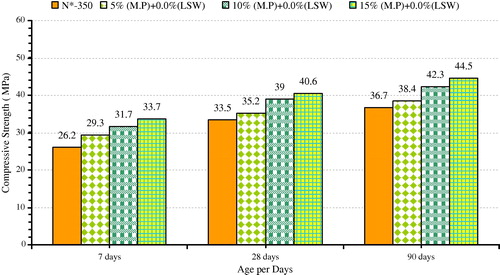
Compressive strength of the concrete has increased with increasing percentages of M.P additions at all curing ages. The highest compressive strength appears when the highest proportion of M.P specimen, especially at early curing ages [Citation15].
Green concrete
Effect of LSW content, with M.P
Compressive strength of green concrete with 25%, 50%, and 75% LSW replacement at different percentages 5, 10, and 15% M.P respectively, are presented in – and . It can be observed that, the compressive strength gradually increased at different ages. Using (25%, 50%, and 75%) LSW with 15% M.P increased the compressive strength about 15%,16%, and 27%) as compared with normal mix N25–350, N50–350, N75–350 at 28 days, respectively. On the other hand using LSW with M.P increased the compressive strength about (9%, 8% and 8%)25, (5%, 7% and 7%)50, (1%, 0.1% and 0.2%)75,respectively as compared with concrete containing M.P only as additive materials, at 28 days.
Normal concrete phase II
Effect of limestone waste (LSW)
Compressive strength test results of normal concrete with LSW with different replacement percentages are presented in and for 0.0%, 25%, 50%, and 75%, respectively. Using LSW with level 25% increased compressive strength of normal concrete about 5%, 0.5%, 5% at 7, 28 and 90 days respectively, as compared with the normal concrete . On the other hand using LSW with levels 50% and 75% decreased compressive strength of normal concrete about (2%, 3%, 1%)50–450, (8%, 8%, 3%)75–450 at 7, 28 and 90 days respectively, as compared with the normal concrete
. The reduction in the compressive strength of concrete is probably due to the large amount of calcium hydroxide resulting from the hydration process of the cement and LSW. Moreover, the loss of the compressive strength at a replacement level 50% and 75% can be related to the increasing of relative of powder for limestone waste as a replacement from sand.
Effect of marble powder (M.P)
Compressive strength test results of normal concrete with M.P with different addition percentages 5%, 10% and 15%, respectively, are presented in and . Using M.P as an additive in the same concrete mixes, it can be seen that, the compressive strength increased about 5%, 16% and 20% for 5%, 10% and 15% M.P as an addition from the cement weight, at 28 days respectively. This is development in compressive strength may be related to the chemical and physical effect of M.P. Moreover, this is development in compressive strength may be due to that the active (SiO2) in marble powder can react with the Ca (OH)2 in concrete to form secondary calcium silicate hydrate and make it chemically stable and structurally dense, this result in agreement with reference [Citation3].
Compressive strength of the concrete has increased with increasing percentages of M.P additions at all curing ages. The highest compressive strength appears when the highest proportion of M.P specimen, especially at early curing ages, this result in agreement with reference [Citation15].
Green concrete
Effect of LSW content, with M.P
Compressive strength of green concrete with 25%, 50%, and 75% LSW replacement at different percentages 5, 10, and 15% M.P, respectively, are presented in – and . It can be observed that, the compressive strength markedly increased at different ages. The highest increase at 15% M.P. Using (25%, 50%, and 75%) LSW with 15% M.P increased the compressive strength about 19%, 20%, and 28% as compared with normal mix N25–450, N50–450, and N75–450 at 28 days, respectively. Moreover, using LSW with 10% and 15%M.P decreased the compressive strength about (4% and 2%)25, (4% and 6%)50, and (3% and 5%)75 as compared with concrete containing M.P only as additive materials, at 28 days, respectively.
Fig. 9 Effect of 25% LSW as a partial replacement of sand weight, with 5%, 10% and 15% MP by weight from cement, phase II (450 kg/m3).
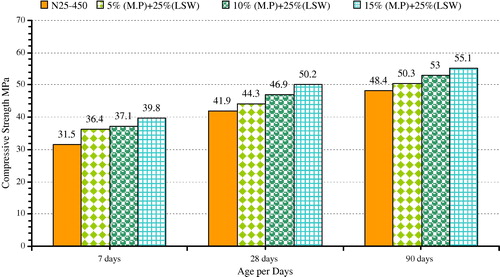
The increase of strength due to the presence of M.P can be related to its physical and chemical effects. The principal physical effect of M.P is that used as filler, which because of its fineness it can fit into spaces between the cement grains and the strength gain up to 7 days is mainly due to this action. The addition of M.P to the concrete improves the compressive strength of concrete; it slightly increased strength compared to that with LSW. From the above results, it can be observed that the partial replacement of river sand with LSW and addition of M.P with 5, 10% and 15% by weigh from cement, may be useful in improving the compressive strength of concrete but it is not such as concrete that contain LSW with S.F the same proportions. In general the compressive strength is decease at LSW is increased more than 50%. Similar findings have been reported is earlier studies [Citation4].
Tensile strength
and and and shows the results of the splitting tensile strength for normal concrete specimens and specimens having 50% LSW as a replacement from sand by weight, with M.P with 15% as addition by weight from cement. The above experiment is being done on the phases I and II.
Table 7 The tensile strength of concrete specimens, for selected mixes, phase I.
Table 8 The tensile strength of concrete specimens, for selected mixes, phase II.
Effect of LSW content, with M.P
Splitting tensile strength of green concrete with 50% LSW replacement at different percentages 15% M.P are presented in and and and . It can be observed that, the splitting tensile strength markedly increased at 28 days. Using 50% LSW with 15% M.P increased the splitting tensile strength about 17% as compared with normal concrete mix . On the other hand using 50% LSW with 15% M.P increased the splitting tensile strength about 8% as compared with normal concrete mix
. Uniform dispersion and disorganized in shape of LSW is vital to the development of cement strength which effectively take advantage of the bond strength properties of LSW.
As shown from ( and ), the ratio of the indirect tensile strength to the compressive strength (fsp/fcu) of the mix containing 50% from LSW as replacement from sand weight, and 15% M.P as an addition by weight from cement, was generally similar to that of the corresponding normal concrete mix at the same cement content. This result agree with [Citation14] who concluded that a very small growing in this noticed for the concrete containing, 50% LSW and 15% M.P as well as the normal concrete mix with the increase of the cement content.
Flexural strength
and and and show the results of the Flexural strength for normal concrete specimens and specimens having 50% LSW as a replacement from sand by weight, with M.P by 15% as addition by weight from cement. The above experiment is being done on the phases I and II.
Table 9 Flexural strength of concrete specimens, for selected mixes, phase I.
Table 10 Flexural strength of concrete specimens, for selected mixes, phase II.
Effect of LSW Content, with M.P
Flexural strength of green concrete with 50% LSW replacement at percentage 15% M.P, are presented in and and and . It can be observed that, the flexural strength markedly increased at 15% M.P. Using 50% LSW with 15% M.P increased the compressive strength about, 7% as compared with normal concrete mix . On the other hand using 50% LSW 15% M.P increased the flexural strength about 8% as compared with normal concrete mix
.
Modulus of elasticity
Effect of LSW content, with M.P
It is obvious from the results of modulus of elasticity of green concrete that the modulus of elasticity increased for with increasing the limestone waste with MP in cement content 350 kg/m3. The limited gain of the modulus of elasticity were 1.2% and 5.3% as compared with normal concrete mix . on the other hand The limited gain of the modulus of elasticity was up to 1.5%, and 3.8% as compared with normal concrete mix
.
Water permeability
The water permeability of concrete are presents the average coefficient of permeability, K, for the three concrete test cylinders. It can be observed that the coefficient of permeability, K, decreases as the dust content increases. The coefficient of permeability was 6.8 × 10−10 cm/sec for normal concrete mix , and 4.62 × 10−10 cm/sec for mix content 15% M.P. As the same time the coefficient of permeability was 4.87 × 10-10 cm/sec for mix content 50% LSW, with 15% M.P.
As the same time is happen in concrete containing cement 450 kg/m3, it can be observed that the coefficient of permeability, K, decreases as the dust content increases. The coefficient of permeability was 6.03 × 10−10 cm/sec for normal concrete mix , and 4.87 × 10−10 cm/sec for mix content 15% M.P. As the same time the coefficient of permeability was 5.13 × 10−10 cm/sec for mix content 50% LSW, with 15% M.P. The addition of LSW to the concrete improves the impermeability of concrete because it blocks the passages connecting capillary pores and the water channels. This blockage is affected by the amount of dust content in the LSW, and the more water passages were blocked, the more reduction in the permeability of concrete specimens is observed. The permeability is decease at LSW is increased, similar findings have been reported is earlier studies [Citation16].
Conclusions
From the analysis and discussion of test results obtained from this research, the following conclusions can be drawn
| 1. | The workability of green concrete did not affected by the LWS percentage. | ||||
| 2. | Using LSW up to 50% replacement increase the compressive strength about 12% at 28 days. | ||||
| 3. | When increasing cement content from 350 kg/cm3 to 450 kg/cm3 in presents of the LSW with different percentage increased the compressive strength about 6% at 28 days. | ||||
| 4. | Cement content of 350 kg/m3, its better performance, and more economical from cement content of 450 kg/m3. | ||||
| 5. | Presences of marble powder with LSW (up to 50%) increase the compressive strength in mixes with low cement content (350 kg/cm3) about 7%. | ||||
| 6. | Indirect tensile strength increased about 17% when using 50%LSW and 15%M.P with different cement content. | ||||
| 7. | Flexural strength increased about 8% when using 50%LSW and 15%M.P with different cement content. | ||||
| 8. | Using MP up to 15% as admixture enhancement the compressive strength. | ||||
| 9. | The rate of the strength gain decreased as the percentage of limestone waste replacement increase more than 50 percent in cement content 350, and 450 kg/m3. | ||||
Notes
Peer review under responsibility of Housing and Building National Research Center.
References
- V.CorinaldesiG.MoriconiT.R.NaikCharacterization of marble powder for its use in mortar and concrete. United StatesConstruction and Building Materials242009113117
- A.ErgünEffects of the usage of diatomite and waste marble powder as partial replacement of cement on the mechanical properties of concrete. TurkeyConstruction and Building Materials252010806812
- M.S.HameedA.S.S.SekarProperties of green concrete containing quarry rock dust and marble sludge powder as fine aggregate. IndiaARPN Journal of Engineering and Applied Sciences4420098389
- K.Shi-CongP.Chi-SunProperties of concrete prepared with crushed fine stone, furnace bottom ash and fine recycled aggregate as fine aggregates. ChinaConstruction and Building Materials23200928772886
- H.DonzaO.CabreraE.F.IrassarHigh-strength concrete with different fine aggregate. ArgentinaCement and Concrete Research.32200217551761
- R.IlangovanaN.MahendranaK.NagamanibStrength and durability properties of concrete containing quarry rock dust as fine aggregate. IndiaARPN Journal of Engineering and Applied Sciences3520082026
- V.CorinaldesiG.MoriconiT.R.NaikCharacterization of marble powder for its use in mortar and concrete United StatesConstruction and Building Materials.242009113117
- H.HebhoubH.AounM.BelachiaH.HouariE.GhorbelUse of waste marble aggregates in concrete. FranceConstruction and Building Materials25201011671171
- ASTM C494–80 type A and F. Standard specification for chemical admixtures for concrete.
- ECCS Egyptian code ECCS 203–2008.
- ESS Part 5 Egyptian Standard Specifications. Method for making test cubes from fresh concrete. 1658–1991.
- ESS Part 4 Egyptian Standard Specifications. Method for making test cylinders from fresh concrete. 1658–1991.
- ESS Part 7. Method of normal curing of test specimens. 1658–1991.
- A.A. Sammy. Mechanical properties for composite cement materials with different fiber. M. Sc faculty of engineering, materials engineering dept. Zagazig University 2007.
- B.DemirelThe effect of the using waste marble dust as fine sand on the mechanical properties of the concrete. TurkeyInternational Journal of the Physical Sciences59201013721380
- T.CelikK.MararEffects of crushed stone dust on some properties of concrete TurkeyCement and Concrete Research.267199611211130
